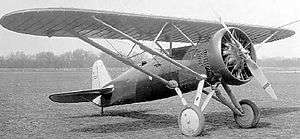
Boeing XP-15
The Boeing XP-15 was a prototype monoplane fighter of the United States, the second to be designated a pursuit type, after the Boeing XP-9.
Design and development
This aircraft was essentially a monoplane version of the Boeing P-12, differing in having the lower wing omitted and in having all-metal construction as well as altered ailerons. The XP-15 had a split-axle undercarriage and a tail wheel.
Boeing numbered the craft as its Model 202; while the United States Army accepted it for testing and designated it as XP-15, they never actually purchased it, and it retained its civil registration of X-270V.
Operational history
The XP-15 first flew in January 1930, when it was discovered that the vertical stabilizer (a P-12C type) needed to be larger in order to compensate for the single wing. Initial testing showed a top speed to 178 mph, but with enlarged tail surfaces and a Townend cowling, it recorded 190 mph at 8,000 ft. The aircraft performed poorly, with a poor rate of climb and a high landing speed. The USAAC did not order the aircraft for production and on 7 February 1931, the prototype was destroyed when a propeller blade failed and the engine tore loose from its mounts.
Podcasts:

